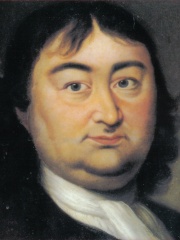
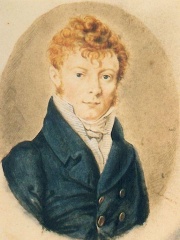
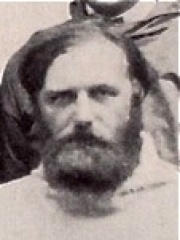
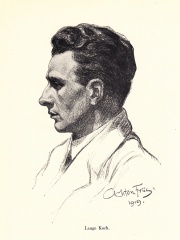
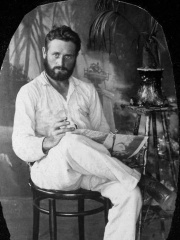
The Most Famous
EXPLORERS from Denmark
Top 6
The following people are considered by Pantheon to be the most legendary Danish Explorers of all time. This list of famous Danish Explorers is sorted by HPI (Historical Popularity Index), a metric that aggregates information on a biography's online popularity.

1. Vitus Bering (1681 - 1741)
With an HPI of 79.77, Vitus Bering is the most famous Danish Explorer. His biography has been translated into 84 different languages on wikipedia.
Vitus Jonassen Bering ( BAIR-ing, BERR-ing, US also BEER-ing, Danish: [ˈviːtsʰus ˈjoːnæsn̩ ˈpe̝(ː)ɐ̯e̝ŋ]; baptised 5 August 1681 – 19 December 1741), also known as Ivan Ivanovich Bering (Russian: Иван Иванович Беринг), was a Danish-born Russian cartographer, explorer, and officer in the Russian Navy. He is known as a leader of two Russian expeditions, the First Kamchatka Expedition and the Great Northern Expedition, exploring the northeastern coast of the Asian continent and from there the western coast of the North American continent. The Bering Strait, the Bering Sea, Bering Island, the Bering Glacier, and Vitus Lake were all named in his honor. Taking to the seas as a ship's boy at age 15, Bering traveled extensively over the next eight years, as well as taking naval training in Amsterdam. In 1704, he enrolled with the rapidly expanding navy of Tsar Peter I. After serving with the navy in significant but non-combat roles during the Great Northern War, Bering resigned in 1724 to avoid the continuing embarrassment of his low rank to his wife, and upon retirement was promoted to first captain. Bering was permitted to keep the rank when he rejoined the Russian Navy later that year. The tsar selected Bering to captain the First Kamchatka Expedition, an expedition set to sail north from Russian outposts on the Kamchatka Peninsula, with the charge to map the new areas visited and establish whether Asia and America shared a land border. Bering departed from Saint Petersburg in February 1725 as the head of a 34-man expedition, aided by the expertise of Lieutenants Martin Spanberg and Aleksei Chirikov. The party took on men as it headed toward Okhotsk, encountering many difficulties before arriving at the settlement. From there, the men sailed to the Kamchatka Peninsula, preparing new ships there and sailing north—repeating a little-documented journey of Semyon Dezhnyov 80 years earlier. In August 1728, Bering concluded that there was clear sea between Asia and America, which he did not sight during the trip. For this expedition, he was rewarded with money, prestige, and a promotion to the noble rank of captain-commodore. He immediately started preparations for a second trip. Having returned to Okhotsk with a much larger, better prepared, and much more ambitious expedition, Bering set off for an expedition to North America in 1741. The expedition spotted Mount Saint Elias, and sailed past Kodiak Island. A storm separated the ships, but Bering sighted the southern coast of Alaska, and a landing was made at Kayak Island or in the vicinity. Adverse conditions forced a return, but he documented some of the Aleutian Islands on his way back. One of the sailors died and was buried on one of these islands, and Bering named the island group Shumagin Islands after him. Bering himself became too ill to command his ship, which was at last driven to seek refuge on an uninhabited island in the Commander Islands group in the southwest Bering Sea. On 19 December 1741, Bering died on the island, which was given the name Bering Island after him, near the Kamchatka Peninsula, reportedly from scurvy, along with 28 men of his company.

2. Johann Karl Ehrenfried Kegel (1784 - 1863)
With an HPI of 67.50, Johann Karl Ehrenfried Kegel is the 2nd most famous Danish Explorer. His biography has been translated into 31 different languages.
Johann Karl Ehrenfried Kegel (October 3, 1784 – June 25, 1863) was a German agronomist and explorer of the Kamchatka Peninsula. He died in Odessa in 1863.

3. Peter Freuchen (1886 - 1957)
With an HPI of 59.16, Peter Freuchen is the 3rd most famous Danish Explorer. His biography has been translated into 20 different languages.
Lorenz Peter Elfred Freuchen (20 February 1886 – 2 September 1957) was a Danish explorer, author, journalist and anthropologist. He is notable for his role in Arctic exploration, namely the Thule Expeditions.

4. Lauge Koch (1892 - 1964)
With an HPI of 56.63, Lauge Koch is the 4th most famous Danish Explorer. His biography has been translated into 18 different languages.
Lauge Koch (5 July 1892 – 5 June 1964) was a Danish geologist and Arctic explorer.
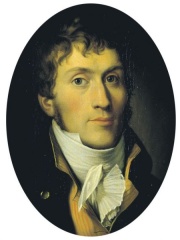
5. Jørgen Jørgensen (1780 - 1841)
With an HPI of 55.49, Jørgen Jørgensen is the 5th most famous Danish Explorer. His biography has been translated into 17 different languages.
Jørgen Jørgensen (name of birth: Jürgensen, and changed to Jorgenson from 1817) (29 March 1780 – 20 January 1841) was a Danish adventurer during the Age of Revolution. During the action of 2 March 1808, his ship was captured by the British. In 1809 he sailed to Iceland, declared the country independent from Denmark–Norway and pronounced himself its ruler. He intended to found a new republic, following the examples of the United States and the French First Republic. He was also a prolific writer of letters, papers, pamphlets and newspaper articles covering a wide variety of subjects, and for a period was an associate of the famous botanists Joseph Banks and William Jackson Hooker. He left over a hundred written autographs and drawings, most of which are collected in the British Library. Marcus Clarke referred to Jørgensen as "a singularly accomplished fortune wooer—one of the most interesting human comets recorded in history".

6. Frans Blom (1893 - 1963)
With an HPI of 54.17, Frans Blom is the 6th most famous Danish Explorer. His biography has been translated into 15 different languages.
Frans Blom (9 August 1893 – 23 June 1963) was a Danish explorer and archaeologist. He was most associated with his research of the Maya civilization of Mexico and Central America.
People
Pantheon has 6 people classified as Danish explorers born between 1681 and 1893. Of these 6, none of them are still alive today. The most famous deceased Danish explorers include Vitus Bering, Johann Karl Ehrenfried Kegel, and Peter Freuchen.
Deceased Danish Explorers
Go to all RankingsVitus Bering
1681 - 1741
HPI: 79.77
Johann Karl Ehrenfried Kegel
1784 - 1863
HPI: 67.50
Peter Freuchen
1886 - 1957
HPI: 59.16
Lauge Koch
1892 - 1964
HPI: 56.63
Jørgen Jørgensen
1780 - 1841
HPI: 55.49
Frans Blom
1893 - 1963
HPI: 54.17
Overlapping Lives
Which Explorers were alive at the same time? This visualization shows the lifespans of the 5 most globally memorable Explorers since 1700.

